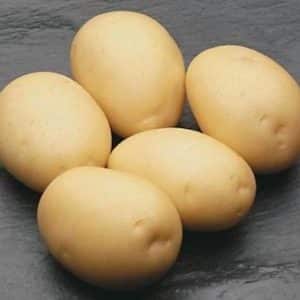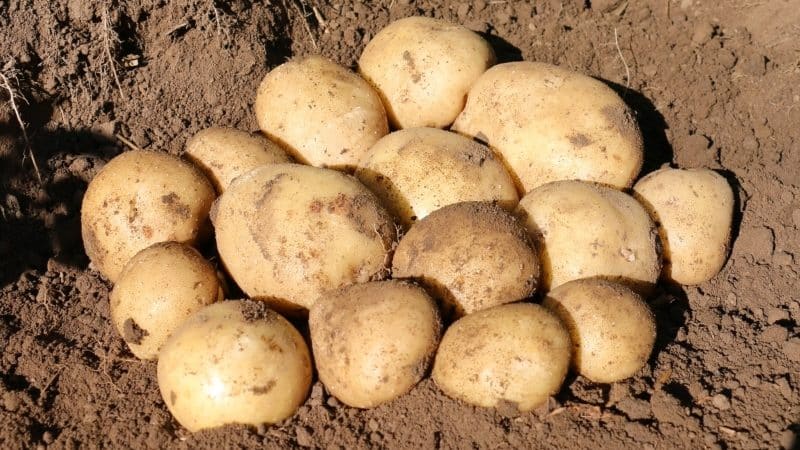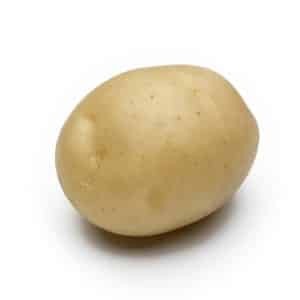An unpretentious potato variety that stores well: “Sifra”
Choosing the right potatoes for planting is not an easy task. When choosing a variety, the duration of ripening, shelf life, yield, taste and disease resistance are taken into account. One of the best options for many summer residents is Sifra potatoes.
In the article we will tell you what its features, advantages and what are the nuances of care.
Description of the variety
The Sifra potato was bred in Holland and entered Russian markets after the variety was entered into the state register in 2010.
Potato composition:
- water;

- starch;
- sugar;
- cellulose;
- raw protein;
- amino acids;
- organic acids;
- minerals;
- amides;
- pectins.
Potatoes are rich in macronutrients:
- phosphorus;
- sulfur;
- silicon;
- sodium;
- magnesium;
- potassium;
- chlorine.
It also contains vitamins C, A, H, E, group B (thiamine, riboflavin, pyridoxine, pantothenic and folic acids).
Potatoes of the Sifra variety ripen from 95 to 110 days and have high yields, maximum indicators are 500 c/ha.
The variety is resistant to various diseases and pests - scab, potato canker, golden nematode, but is weak against fungal diseases, and is moderately resistant to late blight.
Characteristics of Sifra potatoes
Sifra bushes are medium in size. The leaves are small, dark green, and can spread out or stand upright. During the flowering period, the bushes are covered with white flowers collected in corollas. The potatoes are large, smooth and even, oval in shape with a few eyes.The color of the peel is light yellow, the flesh is white or light cream.
The Sifra potato has earned the trust of gardeners for its resistance to the climatic conditions of a number of regions - Central, Northwestern, Central Black Earth, Volga-Vyatka. This variety is actively grown in Moldova and Ukraine.
Important! The Sifra variety is sensitive to frost, so it is better to start planting during a period of stable heat, when the soil has time to warm up sufficiently.
The main advantages and disadvantages of the variety
In addition to immunity to a number of diseases, high yield and aesthetic appearance, the Sifra variety has other advantages.
Unlike super-early ones, it is drought-resistant and can stored longer time. Sifra shows no signs of degeneration. Potatoes of this variety are used in cooking for dietary and baby food and have a pleasant taste.
Disadvantages of the variety:
- sensitivity to sudden drops in temperature;
- special need for nutritious soil.
Features of planting and growing
Places for planting potatoes are prepared in the fall: the soil is dug up to a depth of 30 cm with the addition of humus and ash. The second is added additionally before planting to avoid the appearance of fungus and protect the tubers from rot.
Before planting, they are germinated in a bright place at a moderate temperature (up to +15°C). If sprouts appear earlier than the planned planting, the tubers are temporarily moved to a dark place. Specimens with sprouts 1.5 cm long will be optimal for planting.

Landing scheme and rules
Sprouted potatoes are planted in late spring in thoroughly loosened and moistened soil. The tubers are placed in pre-prepared holes, the depth of which is from 5 to 12 cm, depending on the soil.The tubers are planted at a distance of 30 cm from each other in one row. The distance between rows is about 60 cm.
After planting, the tubers are covered with earth.
Attention! It is not recommended to plant Sifra potatoes in waterlogged and heavy soil. The soil must be dry. The best choice is sandy loam and sandy soils.
Nuances of care
They begin to water the potatoes during flowering - in the evenings, at the rate of 3 liters per bush. Before each subsequent watering, the soil should dry out by about 10 cm. To maintain an optimal level of soil moisture, it is recommended to organize a drip irrigation system.
For feeding, it is preferable to use organic fertilizers – chicken droppings, cow or horse manure. You can feed the soil with complex mineral fertilizers - “Azophoska”, “Ammophoska”, “Ammonia nitrate”. The dosage of fertilizers is calculated according to the instructions, taking into account the level of soil fertility.
It is better to start fertilizing the soil in advance - while plowing the garden, or adding it to the holes when planting. Potatoes are fed about three times during the season - at the first shoots, before flowering and after.
The beds are planted twice a season: when the bushes have reached a height of 15-16 cm and before flowering. To do this, they rake the soil between the rows towards the bush. Hill up manually or using machinery.
Diseases and pests
To prevent potato diseases, plantings are treated twice a season with preparations containing copper. To prevent development late blight, in the spring before planting, treat the ground with a solution of copper sulfate. After processing the area, the soil is dug up.
You can disinfect the soil from fungal infections with stronger preparations "Ridomil" or "Thanos", be sure to follow the manufacturers' instructions.A couple of days before planting potatoes, the tubers themselves are treated with a fungicide - “Alirin-B”, “Metaxil”, “Ordan”, “Raek” are suitable.
For those who do not want to resort to chemicals and want to get an environmentally friendly product from their garden, there are traditional ways to combat fungal diseases:
- Spray the plants once every 14 days with garlic solution. To do this, crushed garlic is placed in a glass of water and left for a day. Afterwards, the solution is filled with water (10 l) and 1 g of manganese is added.
- Spray the bushes once every 14 days with a solution of milk, water and iodine. Prepare according to the following recipe: mix a bucket of water with 1 liter of milk and add 15 drops of iodine.
To avoid the appearance pests (Colorado beetle, mole crickets, potato moths), potatoes are treated with insecticides.
The most effective:
- “Aktara, VDG” – protects against wireworms and aphids;
- “Respect, KS” – saves from the Colorado potato beetle for up to 35 days;
- “Regent, VDG” - destroys the population of the Colorado potato beetle;
- "Emesto Quantum" - helps fight potato moth;
- "Medvetox" - actively fights mole crickets.
Another way to protect plants from pests is to use ash.. It is used at any stage of potato growth. The ash is mixed with water and the resulting solution is sprayed onto the bushes. To enhance the effect, add shavings of laundry soap.
Harvest and storage
Digging of potatoes begins in mid-July, although to get a large harvest it is better to do this in mid-September. The signal to start the procedure is wilting and yellowing of the leaves and stem.
After harvesting, the potatoes are cleared of soil and thoroughly dried. Then they send it for storage in the cellar, in pre-prepared boxes.
Important! Store potatoes in a room with an average humidity of 65% and a temperature of +2...+3°C. If all standards are followed, the harvest will last until spring without losing its appearance or taste.
What difficulties may there be when growing
There are no particular problems when planting and growing Sifra potatoes. The most important thing is not to forget to moisten the soil and treat the plantings against diseases and pests. Frost can cause serious problems.
When they occur, you will have to save the crop in one of the following ways:
- sprinkle the tops with soil;
- cover the bushes with straw;
- cover the plantings with spunbond or plastic film.
To rehabilitate already frozen plants, they are fed.
Tips and reviews about the Sifra variety
 To get a good harvest when growing Sifra potatoes, experienced gardeners recommend:
To get a good harvest when growing Sifra potatoes, experienced gardeners recommend:
- Disinfect tubers with special solutions containing boric acid. For example, add 0.5 g of manganese, 15 g of boric acid and 5 g of copper sulfate to 10 liters of water. This solution will prevent the occurrence of diseases and stimulate the growth of potatoes. Planting material can be sprayed or soaked for a couple of hours.
- Make a small transverse cut on the tubers before planting. This will help the nutrients to be evenly distributed, and the bushes will grow large, the yield will increase by 11%.
- To quickly form tubers, you can use superphosphate feeding at the rate of 2 tbsp. l. per 1 m² of bed.
- Make potato furrows in a direction from north to south. This way the sun will evenly warm each side.
Gardeners talk about the ease of growing this variety and its pleasant taste.
Elena, Kirov: “We grew it last year until we sold the dacha. I was pleased with the taste and size of the potatoes. Also, it is very easy to clean.There have been no problems with growing, we always plant a little, so it may be easier to keep track of it. For those who want to grow good potatoes, I recommend the Sifra variety.”
Larisa, Vologda: “I’ve been growing potatoes for many years, last year I read the description of the Sifra potato variety, looked at the photo and decided to plant it. I sprouted the potatoes for about a month. Before planting, the holes were filled with ash, and the tubers themselves were treated with the “Maxim” preparation a couple of hours before being immersed in the ground. For 10 kg of potatoes, 4 g of the substance was enough. I planted potatoes to a depth of 10 cm. I fertilized the soil with manure and watered the garden 3 times a week (sometimes less often due to rainy weather). I advise you to water by hand; such spot watering ensures good moisture penetration. Well, in general, caring for potatoes of this variety is not particularly different from others. The harvest was collected in early autumn - about 20 kg. Potatoes are medium-sized, neat, even. Some were left for planting.”
Conclusion
Sifra is one of the popular potato varieties among Russian summer residents. The increased interest in it is due to its characteristics: resistance to drought and many diseases, high yield and long-term storage, beautiful appearance and pleasant taste. But due to increased sensitivity to frost and soil, this potato variety is not suitable for all regions.